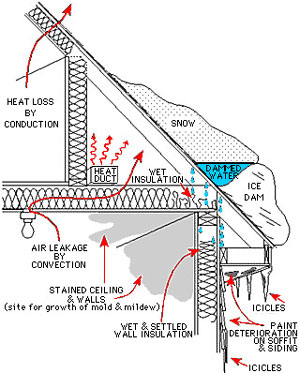Energy audit: planning for winter now
Those guys at Popular Mechanics and IceDamRemovalGuys.com —gotta love ‘em! A recent lead article in Popular Mechanics (September 2018, p11-15) covered the basics of a DIY energy audit—air leaks, humidity, insulation, the attic, and the heating/cooling system—work that is best done when the weather is still nice. And this is the short list; this is do-able. Then the Ice Dam Guys piggy-back on that telling you what you need to know to survive the winter without ice dams. The month to begin this is September and here we are. There’s still time. So what do they all recommend?
The point of the energy audit is to make sure that your energy-saving home is as energy-efficient as it is supposed to be, so, first up is to check for air leaks. Henry Gifford, PM’s building scientist, recommends fancy gadgets and tools to help you find them. He also suggests holding a stick of incense near doors, windows, electrical outlets, and switch plates and watching for movement of smoke. You might also find leaks where you find streaks of dust or extra noise. Once you do locate them, take a caulk gun and a can of spray foam and use what you need to stop the gaps. Some leaks, like in a foundation, might need mortar if they are large. Some leaks, like those around doors, might need weather stripping products. You may experience heat loss from an exposed water heater or pipes. Check exposed parts that might need insulating. Check the humidity of your home to see if you need a de-humidifier. And, check your windows: do you need to replace them with those with a low-emissivity coating or apply a thin coating of film to block the infrared energy? Maybe you need to add an awning or some trees to shade the house? Check your options. Gifford supplies them. He also recommends insulating exterior walls and the underside of the roof deck but not the basement walls. Lastly, Gifford recommends that you purchase a data logger to help you determine if your heating/cooling system is appropriate for the size of your home.
 What do the Ice Dam Guys have to offer? They bring to you free advice as well as professional service. They provide a lot of information on their website so, when you are ready, grab a cup of coffee and dig in. First on their list is: get an energy audit. If the aforementioned DIY version sounds like a bit more than you want to do yourself, then call in a trusted professional to check out your home and make any needed repairs. Once that is done, check September off your list. In October, clean your gutter; clear gutters allow for free flow of water and save you time, money, and frustration when the temperatures drop. In November, shop for a good roof rake if you need one and be prepared for the coming snow. Then, in December, when the snow does fly and begins to accumulate a few inches at a time, start raking. Reach as far as you are able and stick with it throughout the winter. Snow removal is the best way to prevent ice dams but, as the Ice Dam Guys say, to make it work, you must stick with it. For tips on Ice Dam Prevention, go here. You will learn what ice dams are and what causes them, and the top four techniques to prevent them. You will also learn what does NOT work. And, if at any time you need help, they advise that you call a professional.
What do the Ice Dam Guys have to offer? They bring to you free advice as well as professional service. They provide a lot of information on their website so, when you are ready, grab a cup of coffee and dig in. First on their list is: get an energy audit. If the aforementioned DIY version sounds like a bit more than you want to do yourself, then call in a trusted professional to check out your home and make any needed repairs. Once that is done, check September off your list. In October, clean your gutter; clear gutters allow for free flow of water and save you time, money, and frustration when the temperatures drop. In November, shop for a good roof rake if you need one and be prepared for the coming snow. Then, in December, when the snow does fly and begins to accumulate a few inches at a time, start raking. Reach as far as you are able and stick with it throughout the winter. Snow removal is the best way to prevent ice dams but, as the Ice Dam Guys say, to make it work, you must stick with it. For tips on Ice Dam Prevention, go here. You will learn what ice dams are and what causes them, and the top four techniques to prevent them. You will also learn what does NOT work. And, if at any time you need help, they advise that you call a professional.
Energy audits help keep your house functioning well on the inside from top to bottom, providing a safe place for you and your family to live, and prepare the way for an enjoyable season when the outside temperatures drop. Enjoy the winter before a fire or roaring down the ski slopes; wherever you find yourself, may your great Minnesotan winter begin today.
Photo Credit: extension.umn.edu
dudeiwantthat.com

